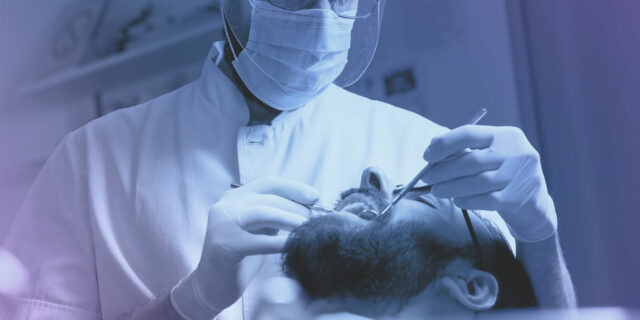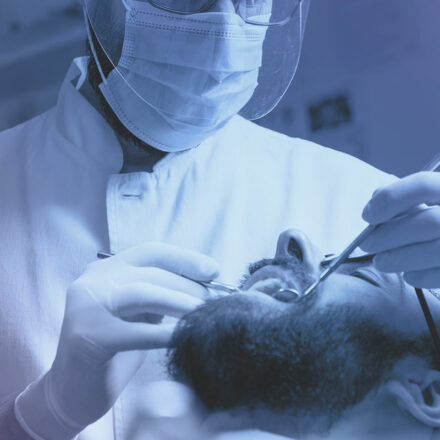Patient 1:
I woke up this morning with a really bad pain in my tooth Mr. Wells.
Mr. Wells:
All right, take a seat and let’s have a look. All right. Open wide.
Walter Isaacson:
Horace Wells was a dentist who cared about his patients. More specifically, he cared about minimizing the pain he inflicted upon them. But during the first half of the 19th century, that wasn’t easy to do. In the early days of modern dentistry, there was nothing to dull the excruciating pain that came with a trip to the dentist. That’s why Horace Wells was so excited by a demonstration he witnessed on December 10th, 1844 in Hartford, Connecticut.
A traveling showman named Gardner Colton is on stage demonstrating the effects of nitrous oxide, better known as laughing gas. While under the influence of the gas, one of the volunteers in the show accidentally injures himself when he hits his leg on a wooden bench. When questioned afterwards, the volunteer tells Wells that the injury caused him no pain whatsoever. And that gives Horace Wells an idea. The next day, he brings Colton to his office, and has him administer nitrous oxide while an associate extracts one of Wells’ troublesome wisdom teeth. After the effects of the gas wear off, Wells declares that he did not feel so much as the prick of a pin, and triumphantly proclaimed that a new era of painless dentistry has arrived.
A few weeks later, Wells decides to introduce the world to the benefits of his new anesthesia. At Massachusetts General Hospital, in front of a large audience of medical students, Wells administers nitrous oxide to a patient. But as he begins to extract a tooth, his patient cries out in pain. The audience in the surgical theater starts to voice their displeasure. Wells is called a charlatan, and a fraud. Unfortunately, Wells had not properly administered the gas. He was unaware that nitrous oxide was less effective on heavy drinkers and the obese, and his patient that day was both.
Professionally disgraced after his failed demonstration, Horace Wells dissolved his dental practice, and a few years later took his own life. It would take another 20 years before the American medical and dental establishments would officially recognize his role in the discovery of anesthesia. And we continue to reap the rewards of Horace Wells’ discovery today. Anesthesia has allowed dentists to perform increasingly intricate and complex procedures with minimal pain to patients. We’ve made enormous strides in conquering dental disease, and promoting oral health. But many challenges remain. That’s why researchers are focusing on disease prevention, and making dental care more affordable and accessible for millions of people around the world. And that’s an idea Horace Wells would’ve happily embraced. I’m Walter Isaacson, and you’re listening to Trailblazers, an original podcast from Dell Technologies.
Speaker 1:
Judy has to see her friend the dentist before she goes to the beach.
Speaker 2:
Would you like to learn how to have strong, healthy teeth?
Speaker 3:
She has been careful to brush her teeth after each meal, and she has brushed her teeth the right way.
Speaker 4:
If you’re so crazy about seeing teeth brushed, here, brush them yourself while I get out of here and let me have some privacy.
Walter Isaacson:
The fact that anesthesia first appeared in dentistry, rather than medicine, was no accident of history. Horace Wells’ patients would have been accustomed to living with chronic pain throughout their bodies. But the pain that came from living with a mouthful of rotting teeth was on an entirely different level. Today, extraction, and the use of heavy anesthetics like nitrous oxide, is usually a last resort. But before the latter part of the 19th century, a toothache was more likely to be treated by someone with no training at all. Often using instruments that they had manufactured themselves.
Mary Otto:
The main solution was just to extract the tooth that was infected or giving someone trouble.
Walter Isaacson:
Mary Otto is the author of the book, Teeth: The Story of Beauty, Inequality, and the Struggle for Oral Health in America.
Mary Otto:
And that fell to different people in the community, whether it was the blacksmith, he was obviously a strong and skilled person, or maybe the apothecary, someone who had a sense of what needed to be done to get this infected, painful tooth out of someone’s jaw. And dental care was basically thought of still as surgical, cared for by people with manual skills, in kind of a mechanical way.
Walter Isaacson:
Barbers were also considered suitable to perform dental work. For centuries, people believed tooth worms, maggot-like creatures that lived inside the mouth were the cause of most dental problems. Bleeding the worms out was one way of getting rid of them. And barbers were called upon to do the job. The red lines that you still see on barber poles today hearken back to the days when barbers were also bleeders. There were no dental schools, and for a long time, there were no books that an aspiring dentist could study to learn his craft.
That began to change in 1728, when a French dentist named Pierre Fauchard published his essay The Surgeon Dentist. Fauchard cataloged best practices for treatment. And for the first time, presented a scientific basis for dental disease that didn’t include tooth worms or other bogus theories. In America, a turning point occurred in the 1840s, thanks to the perseverance of two Baltimore dentists named Horace Hayden and Chapin Harris. Hayden and Harris studied the works of Fauchard, and were convinced there had to be a better way to learn and practice dentistry.
Mary Otto:
These two guys got together and talked about it. They said dentistry is worthy of professional status. They’d seen enough people dying of dental sepsis, where an infected tooth had created a life threatening and a fatal infection in a person. They believed that scientific principles had to be applied to dentistry. And these two men went to the physicians of the College of Medicine in Baltimore and proposed that they had a course of dental training to their medical courses there. But as the story goes, the physicians sent them away with this admonition that the subject of dentistry was of little consequence. These two guys would not take no for an answer though. They set up their own college of dentistry. It was hailed as the world’s first college of dentistry.
Walter Isaacson:
The Baltimore College of Dental Surgery was established in 1840. Other standalone dental schools soon followed. But dentistry was still not considered scientific enough to be included with medical training. It took the work of a pioneering dentist from Illinois, named G.V. Black, to help change that perception.
Mary Otto:
He was trained under the old apprenticeship system. He didn’t attend a dental college, but he was a well known inventor. He patented a cord-driven engine and foot motor for the power dental drills. And he standardized a formula for the dental amalgam that Dennis used to restore teeth to fill fillings. And he developed chart carious lesions, tooth decay, to chart the location of a decayed place on a tooth, advances that were adopted and changed the practice of dentistry for many other practitioners.
Walter Isaacson:
Perhaps Black’s greatest contribution was focusing on cavity prevention and repair. In doing so, he forever shifted the focus of dentistry away from extraction, and set the stage for the great advances in dentistry that we enjoy today. Researchers now have an extraordinary amount of information about the causes of tooth decay, and how to treat and prevent it.
They know, for example, that a clear, sticky film called plaque forms on the surface of our teeth when we don’t brush and floss properly. The acid and bacteria in plaque can eat through the protective outer layer of enamel on our teeth and attack the dentin. That’s the bony tissue that makes up the bulk of the tooth under the enamel. From there, it’s a short trip to the pulp, where the nerves and blood vessels are located. If the pulp gets infected, it can swell and press against the nerve. That’s when we usually head to the dentist for a filling, or possibly a root canal. Then the pulp tissue is removed and the canal is cleaned, filled and sealed. The problem is that those fillings, which are usually made of ceramics, metal or resins, can degrade over time, requiring even more invasive dental work. And that’s led some researchers to wonder if there may be a better way. What if the tooth’s own cells can be used to regrow it, turning a damaged tooth into a healthy one?
Adam Celiz:
Our approach was trying to work with the cells that were in the tooth already, and to place a material that we know from our experiments engineers the cells to do what we want to. And if we replace it into the tooth to stimulate new dentine production.
Walter Isaacson:
That’s Adam’s Silas. He’s a lecturer in the Department of Bioengineering at Imperial College in London. He and his colleagues are working on developing a new kind of filling, made from a synthetic biomaterial that can stimulate stem cell growth in the pulp of the tooth.
Adam Celiz:
It actually restores the tooth to its original form potentially in terms of producing new dentin, rather than putting something in that is inert. And if you were to get a root canal, those teeth are very prone to being removed later down the line because you’re removing a lot of the living matter from the tooth. So this is potentially providing an alternative based on some natural tooth repair and providing new dental tissues, which can enable the tooth to remain viable for longer.
Walter Isaacson:
What Silas is proposing is known as regenerative dentistry. Regenerative dentistry uses cell and molecular biology to repair, rejuvenate and regenerate dental tissues. It’s become the holy grail for dental researchers around the world, but it’s still in its very early stages. So far, Silas’s group has managed to regenerate dentin cells in the lab. Long and costly human trials are still to come, but he’s convinced regeneration will play an important role in the future of dentistry.
Adam Celiz:
So I think there are lots of innovations occurring already in dentistry. And I think approaches that incorporate regenerative medicine won’t be too far behind. It’s just a matter of trying to bridge in the gap in terms of how much these therapies will cost. But I think if these approaches were made available to the patient, they would be popular. And I think they would be really welcomed because I think I certainly would welcome a natural growth of a tissue rather than having something foreign and synthetic implanted in my mouth.
Walter Isaacson:
You don’t have to wait years to experience regenerative dentistry in action. You can actually do it today for just the cost of a tube of toothpaste. Over the millennia, people have tried just about everything to keep their teeth clean. The ancient Egyptians used abrasives like ashes from ground up ox hooves, crushed bones, and burnt eggshells. In Europe in the 18th century, stale toast was ground into a fine powder and used to scrub teeth. By the middle of the 19th century, ingredients also included chalk, soap, and ground charcoal. But until recently, there’s one ingredient that no one has ever thought of adding to toothpaste, glass.
Dr. Swati Nehete:
I’m Dr. Swati Nehete. I’m a senior clinical lecturer at Queen Mary University of London, and a clinical advisor to Biomin.
Walter Isaacson:
Biomin is the name of the glass-filled toothpaste. But Dr. Nehete wants you to know that the glass in Biomin is not the kind found in your windows. This toothpaste has bioactive glass.
Dr. Swati Nehete:
Bioactive glasses are essentially glasses that, when they come in contact with body fluids, they form crystals. The crystals have the ability to bond with dental tissues, bone tissues, any mineralized tissues in the body. Glass that you have in your window does not dissolve on contact with body fluids.
Walter Isaacson:
Bioactive glass forms a rapid, strong and stable chemical bond with tissues. And most importantly, it helps regenerate bones by instructing the body to recruit cells, and start healing. The idea of using what was essentially bone graft material to help prevent cavities and relieve hypersensitivity is a more recent development.
Biomin toothpaste hit the market in the UK in 2016, describing itself as armor for teeth. It uses bioactive glass to attach a durable mineral to the surface of the tooth. The mineral is similar to our tooth enamel, but twice as strong, and more resistant to acid. And unlike standard toothpaste, that armor stays in place, protecting your teeth for up to 12 hours after you’ve stopped brushing. By attaching this armor-like mineral to teeth, and keeping it there throughout the day, Bioglass toothpaste claims off a relief from millions of people who suffer from hypersensitive teeth. And because Bioglass is regenerative, it could actually repair damaged tissue. It might even offer the possibility of a world without cavities. Nehete believes we are just beginning to understand the full potential of bioactive glass.
Dr. Swati Nehete:
We’re trying to use it in dental materials, so the composite filling materials, instead of having the inert material in there as a filler. If we try to use a bit of bioactive glass in there, that’s brilliant, because all of the properties that this toothpaste will give, those will be in that composite. And there’s good research. That’s one avenue we are looking at.
And then we’re looking at root canal treatment materials where we can signal to cells and say, “Hey, start healing here”. Biomin can actually really take this into the next generation of regenerative dentistry, whether it’s using it in orthodontic composites or tooth filling composites, root canal materials, and so many more applications.
Walter Isaacson:
One of the reasons why the research into regenerative dentistry is so urgent is that we’re facing a major global crisis of dental affordability and accessibility. It’s estimated that 2.4 billion people around the world have little to no access to oral health treatment in care. Poor oral health has been associated with some types of cancer, pneumonia, dementia, and other serious diseases. So anything that can reduce the high cost of dental care and make it easier for people to take proper care of their teeth can make a big difference. And one of the most promising approaches on that front involves 3D printing.
Max Lobovsky:
My name is Max Labovsky and I’m co-founder and CEO of Form Labs.
Walter Isaacson:
Max Labovsky first encountered 3D printing when he was about 12 years old.
Max Lobovsky:
My father worked at a big engineering company that had an early machine, and it was kind of a million dollar, room-sized piece of equipment, probably one of the first few dozen machines in the world at the time.
Walter Isaacson:
Labovsky was intrigued by the potential of that giant machine. Then as an undergraduate at Cornell, he joined a group that was building an affordable 3D printer that could fit on a desktop. He’s been building 3D printers ever since. And in 2011, he and his partners started Formlabs. They built 3D printers for professionals, not the mass market, and among their earliest customers were dental labs.
Max Lobovsky:
We started with a Kickstarter campaign. We sold a thousand printers. And even in those first 1000 printers, there were a couple dental labs buying our products. So even though we didn’t market for dental at all, people who knew the technology, and knew dental, saw the opportunity. And then after a couple years, we saw, there are actually some people successful in the dental world using our products. We should start to really target this market and bring solutions dedicated for this market forward. And it came faster than I would’ve expected.
Walter Isaacson:
Today, Formlabs is a leading provider of 3D printers for dentists and dental labs. The machines are used to make crowns, dentures, retainers, and a variety of other products faster and more cheaply than is currently the case.
Let’s say you need a crown for one of your teeth. Today that process will typically start with the dentist taking a mold or impression of your mouth. They’ll send it off to the lab where a technician will make the crown. Then it’s sent back to the dentist. You’ll come in for a fitting. And after all that, the dentist will likely send it back to the lab for some final adjustments. Then you’ll come in for a third appointment and finally get your crown. It’s a time-consuming and expensive process. One that can be greatly simplified with 3D printing.
Max Lobovsky:
And what digital dentistry lets you do is, you get the patient geometry with an intraoral scanner, basically wave a little wand around in your mouth and get a digital model of your mouth. And then in software, you generate the design for the part you want to make, and print it and get an accurate result out. And that whole process can be done, in some cases, in a matter of an hour. You can get better, more accurate results that don’t need adjustment. You can do it faster. You can do it more cost effective, because it cuts out a lot of the expensive labor in the process.
So dentures can cost upwards of a thousand dollars, and cost to produce a denture with our system is on the order of $50. So it can be a very substantial reduction.
Walter Isaacson:
3D printers are rapidly revolutionizing dentistry. Most large labs in America now have them. And over the next few years, as the machines become cheaper and easier to use, they’ll become as ubiquitous in dental offices as x-rays and drills. Labovsky believes that will benefit everyone.
Max Lobovsky:
The thing I’m most excited about is really the broader access. Something like a denture, that’s something that isn’t available to everyone. Even in the developed world, it can be too expensive. And certainly in the developing world, a high quality denture is a non standard thing that people have. But it makes a big impact on a person’s health and mental health, and lots of studies are showing benefits of dental devices like that. And if we can make it so that it’s something that can be produced for tens of dollars, we can get these to many more people than ever had access to. And I think that’s what’s powerful about technology in general, is sort of leveling the playing field. I think we have a real opportunity to do that in the dental world.
Walter Isaacson:
But not every important innovation in dentistry comes in the form of sophisticated technology like 3D printers. Sometimes a revolution can happen by re-imagining an existing piece of technology, including something as rudimentary as the humble toothbrush. Back in the 15th century, the Chinese brushed their teeth by attaching bristles from a pigs neck to a bone or a bamboo handle, Europeans prefer a softer touch. So they replace the pig bristles with horse hairs, sometimes even with feathers. It wasn’t until the invention of nylon in the 1930s that synthetic bristles replaced the real thing. And that’s pretty much where toothbrush innovation stopped.
Michel Koo:
If you look at the design of the toothbrush, it is essentially a bristle on a stick, which remained relatively unchanged for centuries.
Walter Isaacson:
That’s Michel Koo. He’s the director of the Center for Innovation and Precision Dentistry at the University of Pennsylvania.
Michel Koo:
Yes, adding electric motors certainly elevated that basic bristle on a stick format, but the fundamental concept still remained the same, still requires manual dexterity, and is not completely effective. It’s actually a technology that has not been disrupted in decades.
Walter Isaacson:
Koo is part of a multidisciplinary team of engineers, dentists and roboticists who are in the process of thoroughly disrupting the toothbrush. Conventional toothbrushes are not very effective at removing plaque or preventing its formation in the first place. Anyone who has ever sat in a dentist chair while a hygienist picked away at the plaque on their teeth, knows how difficult it can be to remove it. Koo figured that there must be a better way. So he paid a visit to the university’s school of engineering.
Michel Koo:
They were already working, in robotic systems, working with microrobots for totally different applications. And when I came to them and presented the problem, obviously we started to talk, we started to discuss ideas. And by just having people that think differently, having clinicians and also engineers in the same room, talking about a common problem, the ideas started to spread out. And we came up with this idea of using nano particles to bridge, to build, these microrobots to clean up dental plaque.
Walter Isaacson:
This was their big idea, place an army of shape-shifting, plaque eating microrobots, made up of iron oxide nanoparticles, inside the mouth, then subject them to a magnetic field and watch them do everything that a toothbrush and even dental floss can do, only better. And if you think that sounds a bit crazy, you’re not alone.
Michel Koo:
It was funny because in the beginning I was also a little bit skeptical. As a scientist, you are always skeptical first, right? And when the engineers started to show how those nanoparticles really assemble into these bristle-like structures, that was the first time I saw the possibilities of applying nanoparticles, a magnetic field, to form something that can be used to remove plaque. I think it’s the visualization of this nanoparticles, a solution, becoming a bristle-like structure. When I saw that, that’s when it was a moment where I thought it would be possible in terms of plaque removal.
Walter Isaacson:
Koo says the bristles that these nanoparticles would form inside your mouth will look more like a paint brush than a traditional toothbrush. One reason your toothbrush isn’t a very effective plaque fighter is that there are parts of your mouth that are really hard to reach. A second reason, as your hygienist is probably always reminding you, is that there are right ways and wrong ways to brush. These microrobots solve both of those problems.
Michel Koo:
The cool thing here is that the paint brush, or the brush like shape, is built up inside the mouth. So there’s not a particle. So imagine a solution full of little particles, little small, tiny beads. Once you activate the magnetic field, they assemble into this paint brush-like structure, and that brush can move. You can make circular motions, going back and forth, like toothbrushing, but without manual dexterity. That’s totally automated because the magnetic field controls their movements. That’s the beauty of this technology.
Walter Isaacson:
A lot has changed in dentistry since Horace Wells discovered anesthesia and use it to painlessly extract his wisdom tooth. Brushing your teeth with microrobots, 3D printed dentures, repairing decaying teeth with regenerative dentistry. It’s clear that the future of dentistry will look very different from its past. We now have effective treatments for almost all major dental diseases, but the keys to the future will be in prevention and making sure those treatments were affordable and accessible.
Michel Koo:
I think we are in a very interesting crossroad. I think we have gained, and continue to gain, incredible knowledge through research. So in my view, I think a key point for innovation is twofold, how to leverage all these amazing discoveries and knowledge so we can create more precise ways to diagnose, prevent, and treat oral diseases so it can be effective to those who are susceptible. And more importantly, we need to make sure that all these approaches and technologies are accessible and affordable for everyone. I think this together, will guide not only us, but I hope others, in terms of innovating and transforming dentistry as we know today.
Walter Isaacson:
I’m Walter Isaacson, and you’ve been listening to trailblazers, an original podcast from Dell Technologies, who believes there’s an innovator in all of us. If you want to learn more about the guests in today’s episode, please visit delltechnologies.com/trailblazers. Thanks for listening.

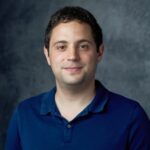 Max Lobovsky
is co-founder and CEO of Formlabs. Formlabs pioneered the new category of professional desktop 3D printing when it launched the world’s first affordable, powerful desktop stereolithography 3D printer.
Max Lobovsky
is co-founder and CEO of Formlabs. Formlabs pioneered the new category of professional desktop 3D printing when it launched the world’s first affordable, powerful desktop stereolithography 3D printer.
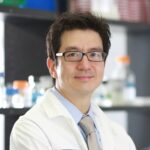 Hyun (Michel) Koo
is a professor in the School of Dental Medicine at the University of Pennsylvania focused on new approaches to study and treat oral diseases using nanotechnology, materials sciences, and robotics. He is the co-founder of the Center for Innovation & Precision Dentistry which bridges clinicians, scientists, and engineers to develop affordable new technologies to address the unmet needs in oral health.
Hyun (Michel) Koo
is a professor in the School of Dental Medicine at the University of Pennsylvania focused on new approaches to study and treat oral diseases using nanotechnology, materials sciences, and robotics. He is the co-founder of the Center for Innovation & Precision Dentistry which bridges clinicians, scientists, and engineers to develop affordable new technologies to address the unmet needs in oral health.
 Swati Nehete
is a clinical advisor to BioMin Technologies. BioMin toothpaste hit the market in the UK in 2016, describing itself as the “armor for teeth.” It uses bioactive glass to attach a durable mineral to the surface of teeth. BioMin bioactive glasses technology aims to create a paradigm shift in the understanding of fluoride and challenge concepts based on established scientific thinking.
Swati Nehete
is a clinical advisor to BioMin Technologies. BioMin toothpaste hit the market in the UK in 2016, describing itself as the “armor for teeth.” It uses bioactive glass to attach a durable mineral to the surface of teeth. BioMin bioactive glasses technology aims to create a paradigm shift in the understanding of fluoride and challenge concepts based on established scientific thinking.
 Mary Otto
is a journalist who began writing about oral health at The Washington Post, where she covered social issues, including health care and poverty. She is the author of the book "Teeth: The Story of Beauty, Inequality and the Struggle for Oral Health In America."
Mary Otto
is a journalist who began writing about oral health at The Washington Post, where she covered social issues, including health care and poverty. She is the author of the book "Teeth: The Story of Beauty, Inequality and the Struggle for Oral Health In America."
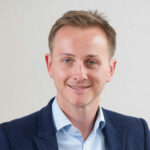 Adam Celiz
is a Senior Lecturer and UKRI Future Leaders Fellow in the Department of Bioengineering at Imperial College London. Celiz gained his PhD at the University of Cambridge and previously undertook postdoctoral studies at the University of Nottingham and Harvard University via a Marie Curie Fellowship. Dr. Celiz’s current research investigates biomaterials for tissue repair and regeneration.
Adam Celiz
is a Senior Lecturer and UKRI Future Leaders Fellow in the Department of Bioengineering at Imperial College London. Celiz gained his PhD at the University of Cambridge and previously undertook postdoctoral studies at the University of Nottingham and Harvard University via a Marie Curie Fellowship. Dr. Celiz’s current research investigates biomaterials for tissue repair and regeneration.
